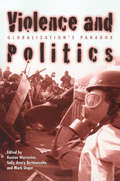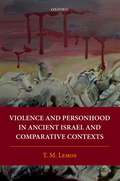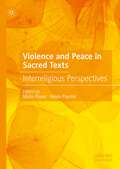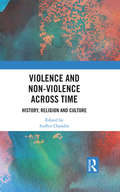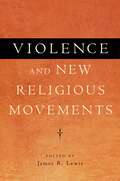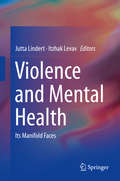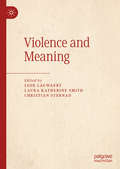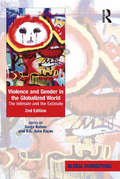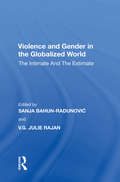- Table View
- List View
Violence and Politics: Globalization's Paradox (New Political Science Reader)
by Kenton Worcester Sally Avery Bermanzohn Mark UngarFirst Published in 2002. Routledge is an imprint of Taylor & Francis, an informa company.
Violence and Politics: Globalization's Paradox (New Political Science Reader)
by Kenton Worcester Sally Avery Bermanzohn Mark UngarFirst Published in 2002. Routledge is an imprint of Taylor & Francis, an informa company.
Violence and Political Theory (And Political Theory)
by Elizabeth Frazer Kimberly HutchingsIs politics necessarily violent? Does the justifiability of violence depend on whether it is perpetrated to defend or upend the existing order – or perhaps on the way in which it is conducted? Is violence simply direct physical harm, or can it also be structural, symbolic, or epistemic? In this book, Elizabeth Frazer and Kimberley Hutchings explore how political theorists, from Niccolo Machiavelli to Elaine Scarry, have addressed these issues. They engage with both defenders and critics of violence in politics, analysing their diverse justificatory and rhetorical strategies in order to draw out the enduring themes of these debates. They show how political theorists have tended to evade the central difficulties raised by violence by either reducing it to a neutral tool or identifying it with something quite distinct, such as justice or virtue. They argue that, because violence is necessarily wrapped up with hierarchical and exclusive structures and imaginaries, legitimising it in terms of the ends that it serves, or how it is perpetrated, no longer makes sense. This book will be an invaluable resource for students and scholars in areas ranging from the ethics of terror and war to radical and revolutionary political thought.
Violence and Personhood in Ancient Israel and Comparative Contexts
by T. M. LemosViolence and Personhood in Ancient Israel and Comparative Contexts is the first book-length work on personhood in ancient Israel. T. M. Lemos reveals widespread intersections between violence and personhood in both this society and the wider region. Relations of domination and subordination were incredibly important to the culture and social organization of ancient Israel often resulting in these relations becoming determined by the boundaries of personhood itself. Personhood was malleable—it could be and was violently erased in many social contexts. This study exposes a violence-personhood-masculinity nexus in which domination allowed those in control to animalize and brutalize the bodies of subordinates. Lemos argues that in particular social contexts in the contemporary "western" world, this same nexus operates, holding devastating consequences for particular social groups.
Violence and Personhood in Ancient Israel and Comparative Contexts
by T. M. LemosViolence and Personhood in Ancient Israel and Comparative Contexts is the first book-length work on personhood in ancient Israel. T. M. Lemos reveals widespread intersections between violence and personhood in both this society and the wider region. Relations of domination and subordination were incredibly important to the culture and social organization of ancient Israel often resulting in these relations becoming determined by the boundaries of personhood itself. Personhood was malleable—it could be and was violently erased in many social contexts. This study exposes a violence-personhood-masculinity nexus in which domination allowed those in control to animalize and brutalize the bodies of subordinates. Lemos argues that in particular social contexts in the contemporary "western" world, this same nexus operates, holding devastating consequences for particular social groups.
Violence and Peace in Sacred Texts: Interreligious Perspectives
by Maria Power Helen PaynterThis volume brings together 11 experts from a range of religious backgrounds, to consider how each tradition has interpreted matters of violence and peace in relation to its sacred text. The traditions covered are Hinduism, Buddhism, Judaism, Christianity, Islam and Sikhism. The role of religion in conflict, war, and the creation of peaceful settlements has attracted much academic attention, including considerations of the interpretation of violence in sacred texts. This collection breaks new ground by bringing multiple faiths into conversation with one another with specific regard to the handling of violence and peace in sacred texts. This combination of close attention to text and expansive scope of religious inclusion is the first of its kind.
Violence and Order on the Chengdu Plain: The Story of a Secret Brotherhood in Rural China, 1939-1949
by Di WangIn 1939, residents of a rural village near Chengdu watched as Lei Mingyuan, a member of a violent secret society known as the Gowned Brothers, executed his teenage daughter. Six years later, Shen Baoyuan, a sociology student at Yenching University, arrived in the town to conduct fieldwork on the society that once held sway over local matters. She got to know Lei Mingyuan and his family, recording many rare insights about the murder and the Gowned Brothers' inner workings. Using the filicide as a starting point to examine the history, culture, and organization of the Gowned Brothers, Di Wang offers nuanced insights into the structures of local power in 1940s rural Sichuan. Moreover, he examines the influence of Western sociology and anthropology on the way intellectuals in the Republic of China perceived rural communities. By studying the complex relationship between the Gowned Brothers and the Chinese Communist Party, he offers a unique perspective on China's transition to socialism. In so doing, Wang persuasively connects a family in a rural community, with little overt influence on national destiny, to the movements and ideologies that helped shape contemporary China.
Violence and Non-Violence across Time: History, Religion and Culture
by Sudhir ChandraThis book probes the complex interweaving, across time and cultures, of violence and non-violence from the perspective of the present. One of the first of its kind, it offers a comprehensive examination of the interpenetration of violence and non-violence as much in human nature as in human institutions with reference to different continents, cultures and religions over centuries. It points to the present paradox that even as violence of unprecedented lethality threatens the very survival of humankind, non-violence increasingly appears as an unlikely feasible alternative. The essays presented here cover a wide cultural–temporal spectrum — from Vedic sacrifice, early Jewish–Christian polemics, the Crusades, and medieval Japan to contemporary times. They explore aspects of the violence–non-violence dialectic in a coherent frame of analysis across themes such as war, jihad, death, salvation, religious and philosophical traditions including Buddhism, Christianity, Judaism, Hinduism, Islam, mysticism, monism, and Neoplatonism, texts such as Ramayana, Mahabharata and Quran, as well as issues faced by Dalits and ethical imperatives for clinical trials, among others. Offering thematic width and analytical depth to the treatment of the subject, the contributors bring their disciplinary expertise and cultural insights, ranging from the historical to sociological, theological, philosophical and metaphysical, as well as their sensitive erudition to deepening an understanding of a grave issue. The book will be useful to scholars and researchers of history, peace and conflict studies, political science, political thought and cultural studies, as well as those working on issues of violence and non-violence.
Violence and Non-Violence across Time: History, Religion and Culture
by Sudhir ChandraThis book probes the complex interweaving, across time and cultures, of violence and non-violence from the perspective of the present. One of the first of its kind, it offers a comprehensive examination of the interpenetration of violence and non-violence as much in human nature as in human institutions with reference to different continents, cultures and religions over centuries. It points to the present paradox that even as violence of unprecedented lethality threatens the very survival of humankind, non-violence increasingly appears as an unlikely feasible alternative. The essays presented here cover a wide cultural–temporal spectrum — from Vedic sacrifice, early Jewish–Christian polemics, the Crusades, and medieval Japan to contemporary times. They explore aspects of the violence–non-violence dialectic in a coherent frame of analysis across themes such as war, jihad, death, salvation, religious and philosophical traditions including Buddhism, Christianity, Judaism, Hinduism, Islam, mysticism, monism, and Neoplatonism, texts such as Ramayana, Mahabharata and Quran, as well as issues faced by Dalits and ethical imperatives for clinical trials, among others. Offering thematic width and analytical depth to the treatment of the subject, the contributors bring their disciplinary expertise and cultural insights, ranging from the historical to sociological, theological, philosophical and metaphysical, as well as their sensitive erudition to deepening an understanding of a grave issue. The book will be useful to scholars and researchers of history, peace and conflict studies, political science, political thought and cultural studies, as well as those working on issues of violence and non-violence.
Violence and New Religious Movements
by James R. LewisThe relationship between new religious movements (NRMs) and violence has long been a topic of intense public interest--an interest heavily fueled by multiple incidents of mass violence involving certain groups. Some of these incidents have made international headlines. When New Religious Movements make the news, it's usually because of some violent episode. Some of the most famous NRMs are known much more for the violent way they came to an end than for anything else. Violence and New Religious Movements offers a comprehensive examination of violence by-and against-new religious movements. The book begins with theoretical essays on the relationship between violence and NRMs and then moves on to examine particular groups. There are essays on the "Big Five"--the most well-known cases of violent incidents involving NRMs: Jonestown, Waco, Solar Temple, the Aum Shunrikyo subway attack, and the Heaven's Gate suicides. But the book also provides a richer survey by examining a host of lesser-known groups. This volume is the culmination of decades of research by scholars of New Religious Movements.
Violence and New Religious Movements
by James R. LewisThe relationship between new religious movements (NRMs) and violence has long been a topic of intense public interest--an interest heavily fueled by multiple incidents of mass violence involving certain groups. Some of these incidents have made international headlines. When New Religious Movements make the news, it's usually because of some violent episode. Some of the most famous NRMs are known much more for the violent way they came to an end than for anything else. Violence and New Religious Movements offers a comprehensive examination of violence by-and against-new religious movements. The book begins with theoretical essays on the relationship between violence and NRMs and then moves on to examine particular groups. There are essays on the "Big Five"--the most well-known cases of violent incidents involving NRMs: Jonestown, Waco, Solar Temple, the Aum Shunrikyo subway attack, and the Heaven's Gate suicides. But the book also provides a richer survey by examining a host of lesser-known groups. This volume is the culmination of decades of research by scholars of New Religious Movements.
Violence and Messianism: Jewish Philosophy and the Great Conflicts of the Twentieth Century (Routledge Jewish Studies Series)
by Petar BojanićViolence and Messianism looks at how some of the figures of the so-called Renaissance of "Jewish" philosophy between the two world wars - Franz Rosenzweig, Walter Benjamin and Martin Buber - grappled with problems of violence, revolution and war. At once inheriting and breaking with the great historical figures of political philosophy such as Kant and Hegel, they also exerted considerable influence on the next generation of European philosophers, like Lévinas, Derrida and others. This book aims to think through the great conflicts in the past century in the context of the theory of catastrophe and the beginning of new messianic time. Firstly, it is a book about means and ends – that is, about whether good ends can be achieved through bad means. Second, it is a book about time: peace time, war time, time it takes to transfer from war to peace, etc. Is a period of peace simply a time that excludes all violence? How long does it take to establish peace (to remove all violence)? Building on this, it then discusses whether there is anything that can be called messianic acting. Can we – are we capable of, or allowed to – act violently in order to hasten the arrival of the Messiah and peace? And would we then be in messianic time? Finally, how does this notion of messianism – a name for a sudden and unpredictable event – fit in, for example, with our contemporary understanding of terrorist violence? The book attempts to understand such pressing questions by reconstructing the notions of violence and messianism as they were elaborated by 20th century Jewish political thought. Providing an important contribution to the discussion on terrorism and the relationship between religion and violence, this book will appeal to theorists of terrorism and ethics of war, as well as students and scholars of Philosophy, Jewish studies and religion studies.
Violence and Messianism: Jewish Philosophy and the Great Conflicts of the Twentieth Century (Routledge Jewish Studies Series)
by Petar BojanićViolence and Messianism looks at how some of the figures of the so-called Renaissance of "Jewish" philosophy between the two world wars - Franz Rosenzweig, Walter Benjamin and Martin Buber - grappled with problems of violence, revolution and war. At once inheriting and breaking with the great historical figures of political philosophy such as Kant and Hegel, they also exerted considerable influence on the next generation of European philosophers, like Lévinas, Derrida and others. This book aims to think through the great conflicts in the past century in the context of the theory of catastrophe and the beginning of new messianic time. Firstly, it is a book about means and ends – that is, about whether good ends can be achieved through bad means. Second, it is a book about time: peace time, war time, time it takes to transfer from war to peace, etc. Is a period of peace simply a time that excludes all violence? How long does it take to establish peace (to remove all violence)? Building on this, it then discusses whether there is anything that can be called messianic acting. Can we – are we capable of, or allowed to – act violently in order to hasten the arrival of the Messiah and peace? And would we then be in messianic time? Finally, how does this notion of messianism – a name for a sudden and unpredictable event – fit in, for example, with our contemporary understanding of terrorist violence? The book attempts to understand such pressing questions by reconstructing the notions of violence and messianism as they were elaborated by 20th century Jewish political thought. Providing an important contribution to the discussion on terrorism and the relationship between religion and violence, this book will appeal to theorists of terrorism and ethics of war, as well as students and scholars of Philosophy, Jewish studies and religion studies.
Violence and Mental Illness: An Overview (SpringerBriefs in Criminology)
by Lia AhonenThis brief summarizes the existing body of knowledge about the links between mental illness and violence, recommends improved methods to deal with potentially violent individuals with mental illness, and identifies pressing implementation and research needs. In public perception and media reports, mental illness and violence - particularly gun violence - are unquestionably linked. However, empirical research presents a more nuanced and complex view of this relationship.Taking into account differences between youth and adults, as well as gender and racial difference, this innovative volume will be useful to policy-makers, legislators, researchers and students interested in addressing the growing public concern about mentally ill individuals at risk for violence.
Violence and Mental Health: Its Manifold Faces
by Jutta Lindert Itzhak LevavViolence is one of the most important challenges, not only for public health systems, but also for public mental health. Violence can have immediate as well as long-term and even transgenerational effects on the mental health of its victims. This book provides a comprehensive and wide-ranging assessment of the mental health legacy left by violence. It addresses the issues as they affect states, communities and families, in other words at macro-, meso- and microlevels, beginning by describing the impact of violence on neurobiology and mental health, as well as the spectrum of syndromes and disorders associated with different forms of violence.The work moves on to tackle violence at the international—and intranational—level before zeroing in on the nature of violence in communities such as villages or city districts. It also examines the results of violence in the family. Each type of violence has distinct effects on mental health and in each chapter specific groups are explored in depth to demonstrate the heterogeneity of violence as well as the diversity of its outcomes in the realm of public mental health. Finally, the book addresses the notion of ‘undoing violence’ by detailing case studies of effective interventions and prevention occurring in countries, communities and families. These cases give us pause to reflect on the nature of resilience and dignity in the context of violence and mental health.All the chapters have been written by leading authors in the field and provide a state-of-the-art perspective. The authors, from different fields of expertise, facilitate interdisciplinary and international insights into the impact of violence on mental health.
Violence and Mental Disorders (Comprehensive Approach to Psychiatry #1)
by Bernardo Carpiniello Antonio Vita Claudio MencacciThis book explores the issue of violence in detail, taking into account the role of contextual factors, as well as the epidemiology, risk factors and clinical aspects of violence related to the main mental disorders. It also offers practical information on its management – from prevention to treatment.Covering all aspects of the problem of violence in mental disorders, the book is divided into four parts: general aspects; risk factors, phenomenology and characteristics of violence in mental disorders; contexts of violence; and prevention and management of violence in mental health. It also discusses violence in the various settings of mental health system, an aspect that has not previously been fully addressed. The volume is intended for all those who are interested in mental health, including scholars, professionals, and students.
Violence and Meaning
by Lode Lauwaert Laura Katherine Smith Christian SternadThis edited collection explores the problem of violence from the vantage point of meaning. Taking up the ambiguity of the word ‘meaning’, the chapters analyse the manner in which violence affects and in some cases constitutes the meaningful structure of our lifeworld, on individual, social, religious and conceptual levels. The relationship between violence and meaning is multifaceted, and is thus investigated from a variety of different perspectives within the continental tradition of philosophy, including phenomenology, post-structuralism, critical theory and psychoanalysis. Divided into four parts, the volume explores diverging meanings of the concept of violence, as well as transcendent or religious violence- a form of violence that takes place between humanity and the divine world. Going on to investigate instances of immanent and secular violence, which occur at the level of the group, community or society, the book concludes with an exploration of violence and meaning on the individual level: violence at the level of the self, or between particular persons. With its focus on the manifold of relations between violence and meaning, as well as its four part focus on conceptual, transcendent, immanent and individual violence, the book is both multi-directional and multi-layered.
Violence and Islam: Conversations with Houria Abdelouahed
by AdonisAdonis' influence on Arabic literature has been likened to that of T. S. Eliot in the English-speaking world. Yet alongside this spearheading of a modernist literary revolution, the secular Syrian-born poet is also renowned for his persistent and staunch attacks on despotism across the Arab world. In these conversations with the psychoanalyst Houria Abdelouahed, Adonis brings into sharp relief the latest wave of violence and war to engulf Arabic countries, tracing the cause of ongoing tensions back to the beginnings of Islam itself. Since the death of the prophet Muhammad, Islam has been used as a political and economic weapon, exploiting and reinforcing tribal divisions to aid the pursuit of power. Adonis argues that recent events in the Middle East – from the failures of the Arab Spring to the rise of ISIS and the bloody war in his native Syria – attest to the destructive effects of an Islamic worldview that prohibits any notion of plurality and breeds violence. If there is to be any hope of peace or progress in the Arab world, it is therefore imperative that these mentalities are overcome. In their place, Adonis urges a new spirit of enquiry, embodied in the freedoms to interrogate the past and to question cultural norms. Adonis' penetrating analysis comes at a critical time, offering an alternative path to the cycle of violence that plagues the Arab world today.
Violence and Inequality: An Archaeological History (Path to Open)
by Thomas P. Leppard Sarah C. MurrayViolence and Inequality explores the deep-time archaeological relationship between violence and inequality, focusing on prehistoric archaeology’s contribution to the understanding of the human dynamics among coercive force, aggression, and the state. Detailed archaeological case studies within a strong theoretical framework built from historical studies consider the role of coercive violence in trajectories toward complexity, how levels and types of violence can be traced alongside emerging wealth disparities, and the social role of violence. The assumption that violence and its threat buttressed elite social control is now challenged from various perspectives. This volume incorporates new models of the relationship between violence and social inequalities into the archaeology of social complexity, building more complicated and nuanced understandings of how different modes of social violence can militate different types of social constitution. Contributions from a variety of methodological angles—such as the bioarchaeology of health and trauma and radiogenic isotope studies and the aesthetics of violence—use a comparative perspective, drawing on data from the Southwestern US, Bronze Age China, early dynastic Egypt, ancient Mesopotamia, Roman Britain, and the Andes. Violence and Inequality offers an original and deep history of violence and inequality. Understanding the long-term intersection of violence and inequality and how they support or erode one another is of intrinsic importance, making this work significant to the study of archaeology, economic history, and collective action.
Violence and Health Care Professionals
by Til WykesTil Wykes BACKGROUND The recent publication of several surveys on violence was the impetus for this book. The first was carried out in 1986 by the Health and Safety Commission Health Services Advisory Committee (1987). They conducted a comprehensive survey of the inddence of violence to 5000 workers in five separate health districts. The results from the 3000 people who eventually replied made many in the caring professions worried. One in 200 workers had suffered a major injury following a violent attack during the previous year and a further one in ten needed first aid following an assault. Other surveys also showed high risks: of sodal service staff, 6% had suffered an attack in the past 5 years (Saunders, 1987), and sodal workers were at even high er risk. 29% had been assaulted in the last 3 years (Rowett, 1986). In addition, 4% of general practitioners had experienced an attack resulting in injury in the past year (D'Urso and Hobbs, 1989). Clinical psychologists were also at risk - 53% had been assaulted at least once during their professional career and 18% in the past year (Perkins, 1991). Media reports of extreme violence seem to be the tip of the iceberg. Many staff are attacked and some of these attacks have serious physical or psychological consequences that interfere with the victim' s ability to return to their full working capadty. This loss of highly trained staff should be recognized by employers and the community.
Violence and Gender in the "New" Europe: Islam in German Culture (Studies in European Culture and History)
by B. WeberWeber contributes to the ongoing scholarly discussion about Islam in the West, demonstrating how current thinking about gender violence prohibits the intellectual inquiry necessary to act against such violence, and analyzes ways in which Muslim women participate in the public sphere by thematizing violence in literature, art, and media.
Violence and Gender in the Globalized World: The Intimate and the Extimate (Global Connections)
by Sanja Bahun V.G. Julie RajanViolence and Gender in the Globalized World expands the critical picture of gender and violence in the age of globalization by introducing a variety of uncommonly discussed geo-political sites and dynamics. The volume hosts methodologically and disciplinarily diverse contributions from around the world, discussing various contexts including Chechnya, Germany, Iraq, Kenya, Malaysia, Nicaragua, Palestine, the former Yugoslavia, Syria, South Africa, the United States, and the Internet. Bringing together scholars’ and activists’ historicized and site-specific perspectives, this book bridges the gap between theory and practice concerning violence, gender, and agency. In this revised and updated edition, the scope of inquiry is expanded to incorporate phenomena that have recently come to the forefront of public and scholarly scrutiny, such as Internet-based discourses of violence, female suicide bombers, and the Islamic State’s violence against women. At the same time, new data and developments are brought to bear on earlier discussions of violence against women across the globe in order to bring them fully up to date. With an international team of contributors, comprising eminent scholars, activists and policy-makers, this volume will be of interest to anyone conducting research in the areas of gender and sexuality, human rights, cultural studies, law, sociology, political science, history, post-colonialism and colonialism, anthropology, philosophy and religion.
Violence and Gender in the Globalized World: The Intimate and the Extimate (Global Connections)
by Sanja Bahun V.G. Julie RajanViolence and Gender in the Globalized World expands the critical picture of gender and violence in the age of globalization by introducing a variety of uncommonly discussed geo-political sites and dynamics. The volume hosts methodologically and disciplinarily diverse contributions from around the world, discussing various contexts including Chechnya, Germany, Iraq, Kenya, Malaysia, Nicaragua, Palestine, the former Yugoslavia, Syria, South Africa, the United States, and the Internet. Bringing together scholars’ and activists’ historicized and site-specific perspectives, this book bridges the gap between theory and practice concerning violence, gender, and agency. In this revised and updated edition, the scope of inquiry is expanded to incorporate phenomena that have recently come to the forefront of public and scholarly scrutiny, such as Internet-based discourses of violence, female suicide bombers, and the Islamic State’s violence against women. At the same time, new data and developments are brought to bear on earlier discussions of violence against women across the globe in order to bring them fully up to date. With an international team of contributors, comprising eminent scholars, activists and policy-makers, this volume will be of interest to anyone conducting research in the areas of gender and sexuality, human rights, cultural studies, law, sociology, political science, history, post-colonialism and colonialism, anthropology, philosophy and religion.
Violence and Gender in the Globalized World: The Intimate and the Extimate (Global Connections Ser.)
by Sanja Bahun-Radunović V. G. Julie RajanViolence and Gender in the Globalized World expands the present discourse on gender and violence, discovering new ways to address the complexities encountered in academic research on the topic. Through the introduction of a variety of uncommonly discussed geopolitical sites and dynamics, the book redefines the critical picture of gender violence in the age of globalization, adopting diverse methodological approaches and various disciplinary praxes in its investigation of the question of violence against women across the globe. With an international team of contributors comprising both scholars and activists, this volume bridges the gap between academic and activist perspectives on gender violence. As such, it will be of interest to anyone conducting research in the areas of gender and sexuality, human rights, cultural studies, political science, history, postcolonialism and colonialism, sociology, anthropology, philosophy and religion.
Violence and Gender in the Globalized World: The Intimate and the Extimate
by Sanja Bahun-RadunovicViolence and Gender in the Globalized World expands the present discourse on gender and violence, discovering new ways to address the complexities encountered in academic research on the topic. Through the introduction of a variety of uncommonly discussed geopolitical sites and dynamics, the book redefines the critical picture of gender violence in the age of globalization, adopting diverse methodological approaches and various disciplinary praxes in its investigation of the question of violence against women across the globe. With an international team of contributors comprising both scholars and activists, this volume bridges the gap between academic and activist perspectives on gender violence. As such, it will be of interest to anyone conducting research in the areas of gender and sexuality, human rights, cultural studies, political science, history, postcolonialism and colonialism, sociology, anthropology, philosophy and religion.
